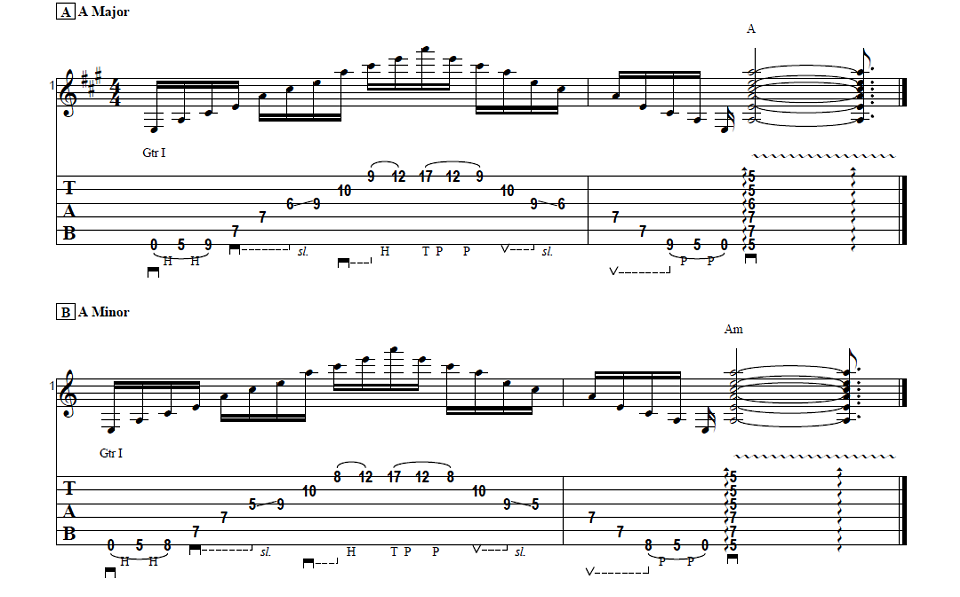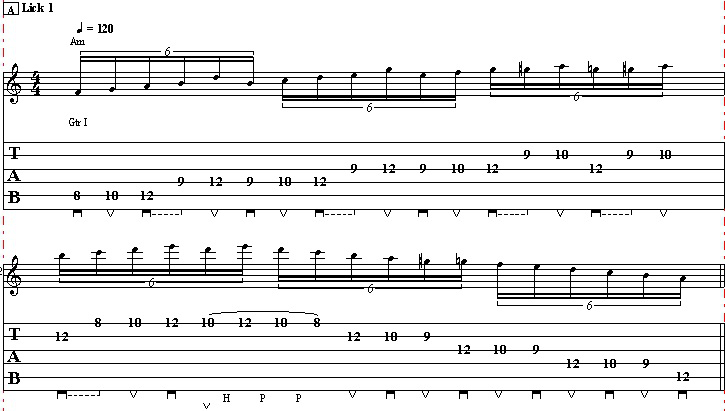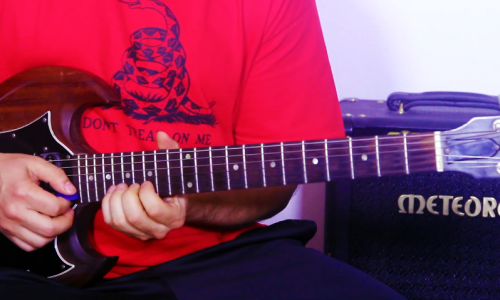Learn to play two killer extended arpeggio guitar licks in A with Guitar Control instructor Darrin Goodman, aka Uncle D. Be sure to get the free tabs to go along with the video instruction and you will rockin’ these killer arpeggio guitar licks tonight!

Introduction
How’s it going everybody? This is Darrin with GuitarControl.com bringing this video Lesson. Today I want to show you how to play a couple of extended arpeggio licks sequences.
Right now Guitar Control is giving away this cool free chord chart, there’s a link down in the description where you can get yours. Every chord you could ever need all neatly compiled into one sheet. So you can print it off, you can throw a copy in your gig bag, put one where you practice. So just in any situation you can have any chord you need at a glance and it’s a free download.
So be sure to click on the link in the description for the tab so let’s get close up and take a look at these arpeggio guitar licks.
Major Arpeggio Sequence
All right so both of these arpeggio guitar licks are movable shapes somewhat, we’ll explain that in a minute. But I just chose this area because it’s kind of a neutral spot for your hand. So if this is like a new thing to you it won’t be a huge deal.
So the first arpeggio guitar licks we’re look at is the major shape. So an arpeggio is basically just the notes of a chord so the major consists of the first third and fifth note of the major scale. So if you’re playing an A major scale we started here on the fifth fret of the low E string because that’s A… So there are our notes to make A major; we need the first, third and fifth notes so when we play the shape we’re just going to go right up through the notes in the scale. So we’re actually going to start this with the open low E string because this is one just to kind of make it a little bit more interesting and a little bit more like a like a lick and little less like your just playing a scale so to say or playing an arpeggio rather. The E is in there, it’s our fifth, so we’re just starting with that so this would be like an inversion. So we’re going to start off we’re going to play the open low E string and then we’re going to do a hammer-on to the fifth fret with your first finger and then a hammer-on to the ninth fret with your third finger… Then we’re going to the seventh fret of the A string and then we’re going to also use that finger and we’re going to roll up to the seventh fret of the D string. So what we’ve got happening here is five, one, three, five, one. Now we’re going to go to three again and we’re going to do now is go to the sixth fret of the G string with your first finger… So when I’m doing this I’m doing it all as a down strokes; so down, Hammer, Hammer, down, down, down… All right, so what we’re going to do now is we’re actually going to shift up and we’re still going to be doing an A major, but we’re going to shift up into another position. So if we play this note here we want to slide to the ninth fret of on the G string… Now we’re going to be looking at our shape here and it looks like a D major chord, it’s your second inversion Triad for those of you who know that. So after we slide up to nine then we’re going to take our second finger and go to the tenth fret of the B string, first finger to the ninth fret of the high E string and then hammer-on to the 12th fret with your pinky. Now we’re going to take our picking hand and we’re going to tap the 17th fret… Now we also want to descend the whole descend thing as well. So with this first, especially if this is like completely new to you, you’re probably going to want to break this into sections. So maybe you could just go… Try to get that down and then you could… until you could… Tight now when we descend it we’re just gonna pull-off to here. So as we climb up we want to leave our trailing fingers on so that way we can just pull, pull and now it’s an upstroke starting on the B string, up, up, slide, up… and then you can pull-off to the open strings and then resolve on an A major barre chord… So that’s the major shape and now I want to show you how to play the minor shape arpeggio guitar licks as well.
Minor Arpeggio Sequence
So just like when you switch a major chord to a minor chord all you’re doing is we’re going to take the note that’s the third of this arpeggio guitar licks and we’re going to flatten it a half step. So when we did here we had a C sharp and E. So now it’s going to be A and we’re going to take the C sharp and flatten it to C. So what’s going to happen is it’s going to change which fingers we use. So now we start off open, hammer-on to five with your first finger, hammer-on to eight with your fourth finger and then we’re gonna take our third finger pick up the seventh fret of the A string and roll up to pick up the second fret of the D string. And now this note that was normally on the sixth fret will be on the fifth because it’s our third. See there? We have that minor dyad shape; minor third dyad shape. Now we’re going to slide up to the ninth fret again to the 10th fret on the B string, but now instead of being the ninth fret of the high E string it’s the eighth fret. So hammer-on to the 12th fret and 17th fret again… And then this one resolved to an A minor chord… All right, so it is a movable shape and depending upon what key you do it in is whether or not you could start with that open string, but if you didn’t start with the open string and you just went… I mean just do it like that, we don’t have the open string, so then you can move this around anywhere you want it. So this is an A, so it’s A major; so if we did it here since it’s a C it’d be a C major. So it’s just still the same shape all the way through. So one of the things you want to pay attention to is how far away the tapped note is. So it is one, two, three, four, five Frets away or two and a half steps, however you want to look at it… So you could in the keys where you can use the open string, you could still do that in there. So like if we were doing it in G; G, D. So E isn’t even part of the major Triad, but it still sounds good because it’s in that key. If we were doing the minor one though… see it still sounds good. It isn’t a clashing note, but I personally probably wouldn’t do it you know if I was playing it down there, but in here in A it sounds really good…
Conclusion
So there you have it. Two extended arpeggio licks with the major and the minor that are movable shapes that you can move to different keys. So if you like this arpeggio guitar licks lesson and you found this helpful and stuff be sure to give it a thumbs up and leave me a comment down below if you have any questions about this or other guitar related topics. If you have not already done so please subscribe to the channel and hit that notification Bell so you don’t miss any of the content that we upload throughout the week. Well that is all I have for you today. Thanks for watching this arpeggio guitar licks lesson and have a great day.



